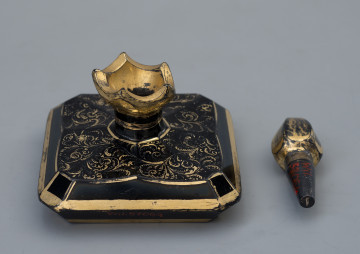
Vial with a cap
Museum of King Jan III's Palace at Wilanów
Part of the collection: Artistic glass
A small, flat vial with a fitted cap, made of hyalith, a type of glass popular in the 19th century. This deeply black material was invented by Georg Franz August Longueval, count of Buquoy (1781–1851). He was a mathematician, a physicist, a chemist, a philosopher as well as an owner of several glass factories. His broad interests and experiments led him to discover a new recipe for molten glass that has the characteristically deep black colour. Its production started in 1817. Owing to the unique hue, products made of hyalith, such as cups, vials, vases, tea containers or candle-holders, quickly became fashionable and widely in-demand.
Vessels made of this material – including this vial from Wilanów – often displayed gilded decorations which looked impressive against the black polished surface and made the items resemble Far Eastern artefacts made of lacquer. They often showed motifs related to art of this region, such as herons, cranes, palm trees, Chinese pavilions and figures of Chinese people performing various activities. However, this vial from the Wilanów collection is decorated with a purely ornamental pattern of sinuous lines. They were drawn with a quill and a steel pen (not a brush) which allowed to obtain a very thin decorative line. This technique was borrowed from porcelain painting.
Author / creator
Dimensions
entire object: height: 4,8 cm, width: 8,1 cm
Technique
gilding,manual forming
Material
copper
Owner
Museum of King Jan III's Palace at Wilanów
Identification number
Location / status

Museum of King Jan III's Palace at Wilanów

Museum of King Jan III's Palace at Wilanów

Museum of King Jan III's Palace at Wilanów
DISCOVER this TOPIC
National Museum in Szczecin
DISCOVER this PATH
Educational path